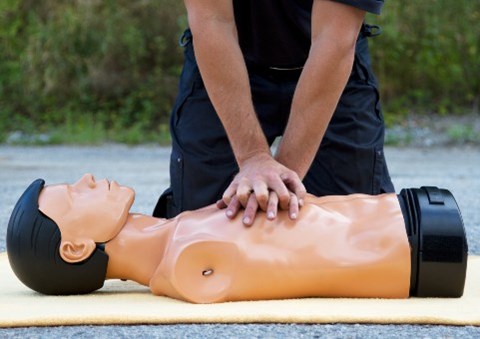Study explores how the public respond when a defibrillator is delivered by drone
News

Study explores how the public respond when a defibrillator is delivered by drone
A new study has looked at how members of the public react when a defibrillator is delivered by drone in a cardiac arrest situation, to find out if it helps – or introduces new problems.
The work has been supported by the National Institute for Health and Care Research (NIHR) Applied Research Collaboration (ARC) North East and North Cumbria (NENC), and the findings have been published in the British Paramedic Journal.
Out-of-hospital cardiac arrest is when a patient’s heart stops suddenly in the community. It is a leading cause of death in the UK as without rapid treatment, it can lead to death within minutes.
We know that early CPR (chest compressions) and fast access to a defibrillator can significantly increase the chances of survival.
Defibrillators are often placed in public places like village halls or shops, but in an emergency, it can be difficult to leave someone to go and fetch one. One approach being tested around the world is using drones to deliver a defibrillator directly to the emergency.
This removes the need to go searching – as it comes to you. But while several countries are testing this technology, there is limited research about how the public would actually respond to using it in a real situation.
Now a new study led by North East Ambulance Service (NEAS) Research Paramedic Owen Finney, has looked at how members of the public might respond when a defibrillator is delivered by drone – to assess whether it helps, or unintentionally introduces new problems.
Owen said: “Only a small percentage of cardiac arrests in the community are treated with a public access defibrillator before an ambulance arrives. Drones may offer a way to get vital equipment to patients faster, but we need to understand how members of the public respond to this technology in a real emergency.
“Our study found that people generally support the idea of drones helping in emergencies, but many still feel unsure about how to use the defibrillator or what to do if they’re alone.
“Pausing CPR for too long to collect the device, concerns about leaving the patient to collect the defibrillator, confusion about how to use the equipment, and fear of doing the wrong thing could all reduce the potential benefit. Good support from ambulance call handlers was highlighted as a very important.
“Ultimately, drone-delivered defibrillators could improve access to life-saving treatment, but only if the public feels confident about the technology and how to use it.”
About the study
In the first part of the study, members of the public took part in a simulated cardiac arrest scenario at Sunderland University, performing CPR on a dummy with live guidance from an ambulance call handler, with a defibrillator ‘delivered by drone’ arriving during the situation.
Researchers looked at how the members of the public interacted with the technology during a simulated cardiac arrest and measured how long CPR was paused to collect the device. They also collected feedback on the experience.
Most performed CPR well but found the overall situation stressful. CPR was paused for up to two minutes while participants went to retrieve the defibrillator. Many thought that the drone delivery was a good idea but found the defibrillator confusing to use. Participants also said that the support from ambulance call handlers was particularly helpful in the situation.
In the second part of the study, a separate group of adults aged over 65 were interviewed to understand their thoughts and feelings about drones delivering defibrillators. They generally supported the idea, but many felt unsure or anxious about using the defibrillator correctly.
They also highlighted the need for more public education and reassurance about the technology if it was to be introduced.
Read a plain language summary of the research
Crucial to understand the impact
While drone-assisted defibrillator delivery is being trialled in other countries, regulatory barriers in the UK currently restrict its widespread testing or use – although there is some work underway, including a study funded by NIHR. However, alongside work on the technical delivery mechanisms, this study highlights how important it is to understand the potential impact on patients and those delivering CPR.
There are also challenges to explore around how drone delivery would fit with existing emergency response systems, and whether it would offer good value for money.
Owen Finney developed this study as part of a master’s degree in clinical research funded by the National Institute for Health and Care Research (NIHR) Applied Research Collaboration (ARC) North East and North Cumbria (NENC), delivered by Newcastle University.
The work was carried out in collaboration with the University of Sunderland and the North East Ambulance Service (NEAS) NHS Foundation Trust.
Read more about the study, here